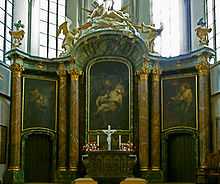Bernhard Rode

Bernhard Rode (25 July 1725 – died 28 June 1797) was a Prussian artist and engraver well known for portraying historical scenes and allegorical works. He knew most of the central figures in the Berlin Enlightenment as Friedrich Nicolai and Gotthold Lessing, and the philosophical and political discussions of the Berlin Philosophs informed much of the subject matter of his artistic work. His paintings include several works depicting, in various guises, the King of Prussia Frederick the Great, who ruled the Prussia during much of Rode's lifetime. Rode was director of the Berlin Academy of the Arts from 1783 until his death in 1797.
Family and early training
Rode was the son of a goldsmith Christian Bernhard Rode and his wife, Anna Sophie. The copper engraver Johann Heinrich Rode and the sculptor Philipp Rode were his brothers. He received his earliest artistic training from his father and his earliest training in drawing from a painter, N. Müller. His four-year education at the studio of the court painter Antoine Pesne, an influential painter in Berlin and Brandenburg, was important to his professional development. During his apprenticeship, he learned to paint portraits. In 1748, Rode began a study trip of several years. He spent 18 months in the studio of Jean Restout and Charles André van Loo (sometimes known as Carle van Loo or Vanloo). He became acquainted with Jean-Baptiste Deshayes and developed his talent and interest in the medium of history painting. In Venice and Rome, he studied the old masters. In 1755 or 1756, he returned to Berlin, and he married Sophie Luise, but the earliest years of their marriage remained childless. of his earliest years in Berlin, not much more is known.
Career

Through a life's pension of the estate of his father, Rode was financially independent, especially important in these years as he established himself professionally and artistically. Through this pension, Rode could explore techniques, themes and formats on his own time, rather than be constrained by the demands of a patron. He painted and donated the Altar pictures for his parish, which today are in the Marienkirche, in Berlin-Mitte. He also portrayed a fictional version of the Emperor of China in a series of paintings.[1]
Because he had studied at the Academy of Art, he regularly received instruction from the director, Blaise Nicholas Le Sueur and Daniel Chodowiecki. Beginning in 1785, he developed a health problem, although he remained active until shortly before his death. Upon his death in 1797, he was buried in the cemetery of the Saint Nicholas and Saint Mara parishes, in Berlin's Königsstadt, where he had donated much of the artwork.

Beginning in 1756, Rode belonged to the Berlin Academy of the Arts. In 1783 he followed Le Sueurs as director of the academy. In 1783, his long-time friend, Daniel Chodowiecki, also a member of the Academy, supported the appointment, and suggested a new undertaking. He and his colleagues at the Academy hoped to take the Academy in a new direction, and suggested a ten-year project, under the name "Soldier King" (German: Soldatenkönig). The project received support from Frederick II's nephew and heir, Frederick William II. In the course of the project, Rode painted several historical depictions of the Soldier King, Frederick the Great. These were displayed in a special exhibit in 1795.[2] Chodowiecki himself took over the important post of the Academy director after Rode's death in 1797 when, under the patronage of Frederick William II, he became the director of the Academy.
Place in the Berlin Enlightenment
Central to the Berlin Enlightenment, in 1750 he was part of a learned society of friends, including the publisher and bookseller Friedrich Nicolai – the poet and philosopher Karl Wilhelm Ramler the Philosoph Johann Georg Sulzer and Thomas Abbt and also Gotthold Ephraim Lessing and Moses Mendelssohn. They pursued literary and literary interests, often linked with the goal of civil emancipation; at the same time, they were loyal and patriotic to the State of Prussia. The union of the civil enlightenment and the state of Prussia and its King bespoke their underlying national goals, and the advancement of German language and literature. Although he did not belong to the innermost circle of this intellectual company, many were Rode's close friends and among them he developed the goals and basis of his work.
See also
| Wikimedia Commons has media related to Bernhard Rode. |
References
- ↑ Lee p.231
- ↑ Berlin Art Academy, "Friedrich der Große und der Feldscher um 1793–94, von Bernhard Rode." Katalog der Akademieausstellung von 1795. Berlin, 1795.
Bibliography
- Lee, Thomas H. C. China and Europe: images and influences in sixteenth to eighteenth centuries. University of Hong Kong Press, 1991.
- Berlin Art Academy, "Friedrich der Große und der Feldscher um 1793–94, von Bernhard Rohde." Katalog der Akademieausstellung von 1795. Berlin, 1795.
| Preceded by Blaise Nicholas Le Sueur |
Director Berlin Academy of Art 1785–1797 |
Succeeded by Daniel Chodowiecki |
|